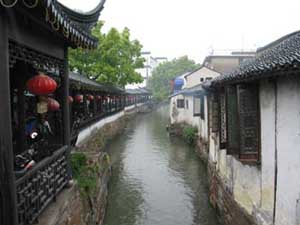
On the border between Jiangsu Province and Shanghai, stands the historic town of Jinxi - a place which awakens long-forgotten memories of how life was lived in the water towns on the lower reaches of the Yangtze River.
Foreigners believe Jinxi is a paragon of Yangtze River water towns and that its beauty surpasses that of Suzhou. The late well-known writer Shen Congwen described it as "a dreaming damsel" while Feng Yingzi, quoting an ancient Chinese line, said it "looks as becoming as ever, whether in light or heavy make-up".".
It is a town happily nestling in its quiet natural environment. The neighboring centers of Zhouzhuang and Tongli, by attracting hordes of tourists, help Jinxi maintain its tranquil atmosphere.
The town is named after the Jinxi River which zig-zags through the town from north to south. Taking a bird's eye view of the town at twilight, one would see the green waters rippling and the houses of families residing on the riverbanks are reflected in the clear water. During the day, the bright sun covers the surface of the water with a golden light.
Town of bridges
Walking through the covered corridors along the Jinxi River, the visitor will find bridges built in various styles over the town's many "water alleys". The old town is small, covering an area of less than 1 square kilometer. However, it has 26 stone bridges, the highest "density" of bridges in the water towns of the south.
Most of the bridges date from the Ming (1368-1644) or Qing (1644-1911) dynasties with some built in the architectural styles of earlier dynasties.
Renovation work in recent years has restored the venerable bridges to their former glory and the observant visitor will enjoy the exquisite craftsmanship to be seen in the bridges' arches and beams. The inscriptions and poetic couplets on the bridges describe the history of their construction and the story of the town over the centuries.
History abounds everywhere. One stone bridge with a wooden railing is known as "The Bridge of Pictures" or "The Red Railing" since it is painted vermilion. This bridge is a reflection of an architectural style that dates back to the Tang Dynasty (618-907).
Tomb of Concubine Chen
At one time in its long history, Jinxi had another name Chenmu (literally, "The tomb of the concubine Chen")"). In 1163, during the Song Dynasty (960-1279), the Emperor Song Xiaozong and his beloved concubine Chen came by Jinxi while traveling through the region. The concubine became obsessed with the natural beauty of Jinxi and she decided to remain in the town for a while. Tragically, she died in Jinxi and the Emperor, grieving over the death of his beautiful concubine, laid her bones in Wubao Lake to the south of the town. He ordered Jinxi to change its name to Chenmu and a Buddhist Temple known as the Lotus Pond was built in Chen's memory.
The temple today is a major attraction to visitors to the town. Construction of the temple began in 1164 (the year after Chen's death) and lasted nearly 40 years. The temple consisted of a palace hall, rooms along the veranda surrounding the hall, a meditation room, pavilions, courtyards and a gaily-painted pleasure-boat.
The scale of the temple rivaled other more famous ones in China in those days. In 1656, during the Qing Dynasty, Halls for the Goddess of Mercy (Guanyin) and Maitreya (Mile) and a Hall of Great Compassion were added to make the temple a first-rate Buddhist retreat.
Disaster struck in 1767 when a conflagration devastated part of the temple. However, extensive renovations and rebuilding in the past eight years have given today's visitors a glimpse of its former splendor.
Travel Tips:
Through Ticket: 30 yuan (US$3.6)
Transportation: It's located at southwest of Kunshan city in Jiangsu Province with about 40 mins driving from Shanghai and bus is also available in Shanghai.
(Shanghai Star August 5, 2004)
|

